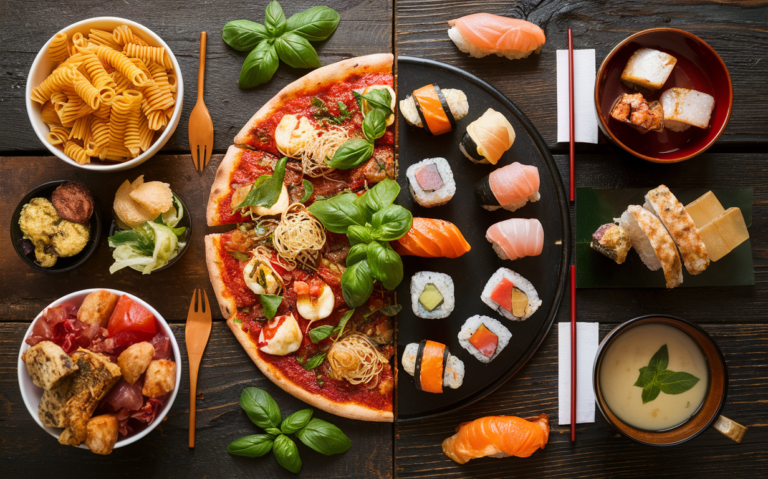Food is a universal language, transcending borders and cultures to bring people together. When it comes to global cuisines, two of the most beloved and distinctive are Italian and Japanese. Each offers a unique culinary experience, filled with rich traditions, flavors, and techniques that reflect their respective cultures. In this article, we’ll delve into the age-old question: Would you rather eat Italian food or Japanese food? We’ll explore the intricacies of both cuisines, considering taste, health benefits, cultural significance, and more. By the end, you might find yourself swayed one way or the other, or perhaps, you’ll appreciate both even more.
The Flavor Profiles: A Symphony of Tastes
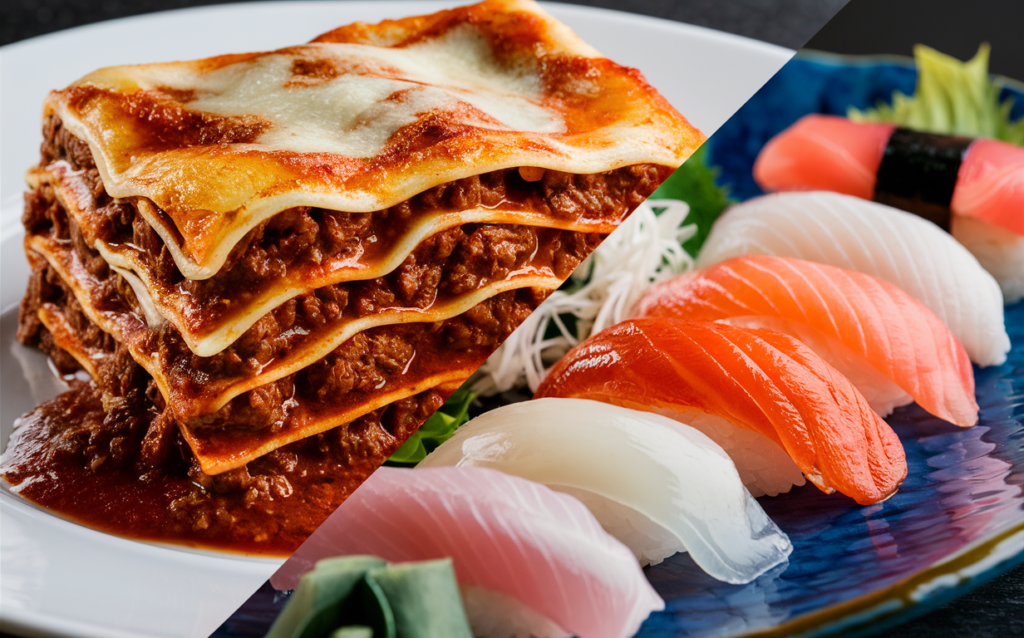
Italian Cuisine: Bold and Hearty
Italian cuisine is renowned for its hearty and comforting flavors. Imagine biting into a slice of pizza with a perfectly crisp crust, tangy tomato sauce, gooey mozzarella, and fresh basil. Each ingredient shines, contributing to a harmonious taste that is both satisfying and comforting. Pasta dishes, another Italian staple, range from the simplicity of spaghetti aglio e olio (garlic and oil) to the richness of lasagna, layered with meat, cheese, and béchamel sauce.
Japanese Cuisine: Delicate and Refined
Conversely, Japanese cuisine is celebrated for its delicate and refined flavors. Sushi, perhaps the most iconic Japanese dish, balances the umami of raw fish with the subtle acidity of vinegared rice. The art of sushi lies in its simplicity and the quality of ingredients. Tempura, another popular dish, features lightly battered and fried vegetables or seafood, maintaining a light and crisp texture that enhances the natural flavors of the ingredients.
Biased Outlook: Italian food often feels like a warm embrace, with its bold and robust flavors that cater to the comfort food lover in all of us. The rich sauces, the generous use of cheese, and the hearty servings make it a favorite for those seeking indulgence. In contrast, Japanese food, with its emphasis on fresh, raw ingredients and minimalist presentation, appeals to those who appreciate subtlety and elegance in their meals.
Learn more about the cultural significance of food and how it shapes our daily lives at DilemmaBox.com.
Health Benefits: Nourishing Body and Soul
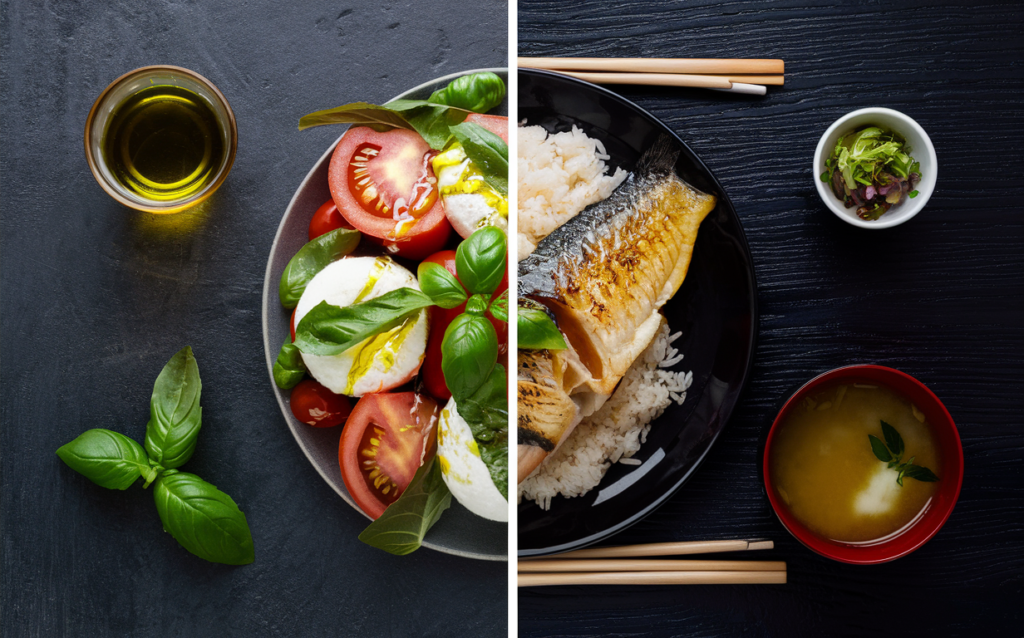
Italian Cuisine: The Mediterranean Diet
Italian cuisine offers a range of health benefits, especially when traditional Mediterranean ingredients like olive oil, tomatoes, and fresh vegetables are used. The Mediterranean diet, often associated with Italian food, is lauded for promoting heart health, reducing inflammation, and supporting weight management. Dishes like caprese salad, with its fresh tomatoes, mozzarella, and basil drizzled with olive oil, showcase the healthful ingredients typical of Italian fare.
Japanese Cuisine: Balance and Longevity
Japanese cuisine is equally celebrated for its health benefits. The traditional Japanese diet is rich in fish, seaweed, rice, and vegetables, contributing to Japan’s reputation for longevity and low rates of obesity and heart disease. Miso soup, a staple in Japanese meals, contains probiotics that support gut health, while green tea, commonly consumed in Japan, is packed with antioxidants.
Biased Outlook: While Italian food is often perceived as indulgent, it also offers plenty of healthy options that can be both delicious and nutritious. On the other hand, Japanese food’s reputation for being healthy is well-deserved, with its balanced approach to nutrition and portion sizes. However, some might find the flavors too subtle and the portions too small compared to the heartiness of Italian dishes.
Discover more strategies for maintaining a healthy diet with our in-depth articles at DilemmaBox.com.
Cultural Significance: More Than Just Food

Italian Cuisine: Tradition and Family
Italian food is deeply rooted in tradition and family. Meals are often seen as an opportunity for connection and celebration. Sundays are reserved for family gatherings, where dishes like pasta and roast meats are shared, creating a sense of belonging and continuity. Festivals and holidays in Italy are also marked by specific foods, such as panettone during Christmas or colomba during Easter.
Japanese Cuisine: Ritual and Mindfulness
Japanese cuisine, meanwhile, is imbued with ritual and mindfulness. The Japanese tea ceremony, or chanoyu, is a perfect example of how food and drink are integrated into cultural practices to promote peace, respect, and contemplation. Meals in Japan are often accompanied by expressions of gratitude, such as saying “itadakimasu” before eating, which acknowledges the effort and sacrifice involved in bringing the food to the table.
Biased Outlook: The communal and celebratory nature of Italian meals can make them feel more vibrant and emotionally fulfilling. The traditions around Italian food often involve warmth and togetherness, creating lasting memories. Japanese food, while equally rich in tradition, tends to focus on mindfulness and appreciation, which might appeal more to those who seek a more introspective dining experience.
Learn more about the cultural rituals associated with food and their impact on our daily lives at DilemmaBox.com.
Real-Life Examples: Personal Stories and Experiences
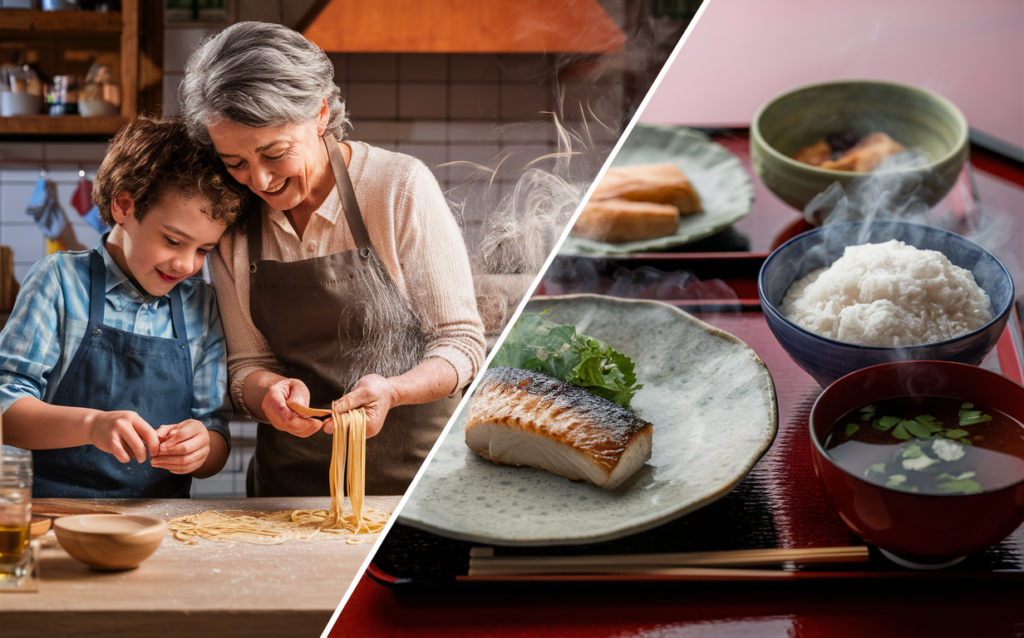
Italian Food: Family and Tradition
Consider Maria, a second-generation Italian-American who grew up in a household where Sundays meant homemade pasta and sauce simmering on the stove. The smell of garlic and tomatoes would fill the house, drawing family members to the kitchen. For Maria, Italian food is synonymous with family, love, and tradition. Each bite of her grandmother’s lasagna takes her back to those cherished Sundays.
Japanese Food: Heritage and Comfort
Then there’s Kenji, a Japanese expatriate living in New York. He fondly recalls the quiet mornings in Tokyo, where he’d enjoy a simple breakfast of rice, miso soup, and grilled fish before heading to school. The taste of fresh sushi reminds him of family celebrations, where they would gather around the table, each piece of sushi a small work of art. For Kenji, Japanese food is a connection to his heritage and a source of comfort in a foreign land.
Biased Outlook: Personal stories often reveal the deep emotional connections people have with their native cuisines. Italian food, with its rich and hearty dishes, often becomes a symbol of home and family. Japanese food, on the other hand, can evoke a sense of tranquility and connection to nature, reflecting the culture’s emphasis on harmony and balance.
Read more personal stories and how food shapes our identities at DilemmaBox.com.
Cooking Techniques: Artistry in the Kitchen
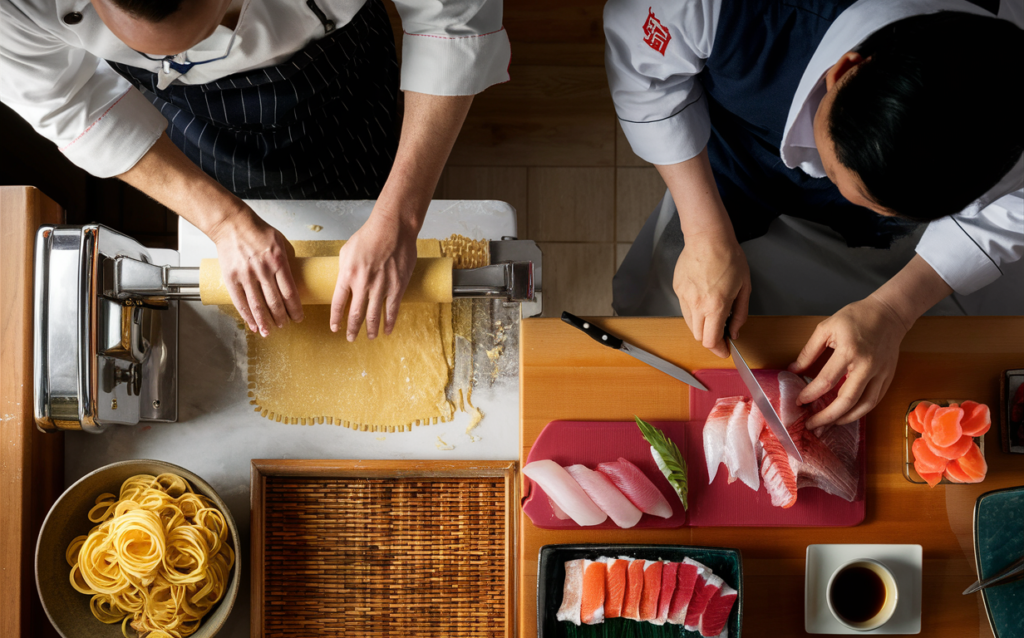
Italian Cooking: Simplicity and Tradition
Italian cooking techniques are often passed down through generations, with an emphasis on simplicity and the quality of ingredients. Techniques like slow-cooking sauces, hand-rolling pasta, and baking bread are cherished skills in Italian kitchens. The process of making a perfect risotto, for example, requires patience and attention to detail, as the rice is slowly stirred and cooked to achieve the perfect creamy consistency.
Japanese Cooking: Precision and Artistry
Japanese cooking techniques, while also emphasizing quality, often involve more precision and subtlety. Sushi chefs, for instance, train for years to master the art of sushi-making, perfecting the balance of rice and fish and the exactness of their knife skills. Techniques such as tempura frying, which involves coating ingredients in a light batter and frying them at a precise temperature, highlight the meticulous nature of Japanese cuisine.
Biased Outlook: Italian cooking techniques, with their emphasis on heartiness and tradition, can be more accessible and comforting for home cooks. The precision and artistry required in Japanese cooking might be intimidating to some but can also be incredibly rewarding for those who appreciate the beauty in culinary craftsmanship.
Explore more cooking techniques and tips to elevate your culinary skills at DilemmaBox.com.
The Dining Experience: Atmosphere and Ambiance

Italian Restaurants: Warm and Inviting
Dining at an Italian restaurant often feels like being welcomed into someone’s home. The atmosphere is warm and inviting, with the aroma of freshly baked bread and simmering sauces filling the air. Italian restaurants tend to be lively, with conversation and laughter creating a sense of community and celebration. The experience is as much about the people and the atmosphere as it is about the food.
Japanese Restaurants: Serene and Elegant
Japanese dining experiences, however, can range from the tranquil and serene to the bustling and energetic. Traditional Japanese restaurants often emphasize simplicity and elegance, with a focus on the presentation of food and the ambiance of the dining space. The experience of dining at a sushi bar, for example, is one of quiet appreciation and mindfulness, where each piece of sushi is savored and the skill of the chef is admired.
Biased Outlook: The convivial atmosphere of Italian dining can make meals feel more joyful and communal. In contrast, the serene and refined environment of Japanese dining might appeal to those who prefer a more contemplative and focused dining experience.
Discover more about dining experiences and how they enhance our enjoyment of food at DilemmaBox.com.
In conclusion, the choice between Italian and Japanese cuisine is a delightful dilemma that ultimately depends on personal preferences and cultural experiences. Both cuisines offer rich, diverse flavors, significant health benefits, and profound cultural traditions. Italian cuisine, with its hearty and comforting dishes, often evokes a sense of home and family. Japanese cuisine, with its refined and subtle tastes, emphasizes mindfulness and harmony. Whether you find yourself drawn to the warmth of Italian dining or the tranquility of Japanese meals, both offer unique and enriching culinary journeys.
FAQ:
- What are the main differences between Italian and Japanese cuisine?
Italian cuisine focuses on hearty, bold flavors and communal dining, while Japanese cuisine emphasizes delicate, subtle tastes and mindful eating. - Which cuisine is healthier, Italian or Japanese?
Both cuisines offer health benefits. Italian food, particularly the Mediterranean diet, is known for heart health, while Japanese food is celebrated for its balanced nutrition and longevity benefits. - What are some iconic dishes from Italian and Japanese cuisines?
Iconic Italian dishes include pizza, pasta (such as spaghetti and lasagna), and risotto. Iconic Japanese dishes include sushi, tempura, and miso soup. - How do Italian and Japanese cuisines handle dessert?
Italian desserts like tiramisu, gelato, and cannoli are rich and indulgent. Japanese desserts, such as mochi and matcha-flavored treats, are often lighter and less sweet, focusing on delicate flavors. - What are the cultural significances of Italian and Japanese foods?
Italian food is often associated with family gatherings, celebrations, and a sense of warmth. Japanese food emphasizes ritual, mindfulness, and a connection to nature and tradition. - How do the dining experiences differ between Italian and Japanese restaurants?
Italian dining experiences are typically lively and communal, while Japanese dining can range from serene and refined to energetic and focused on the culinary artistry.
Sources:

